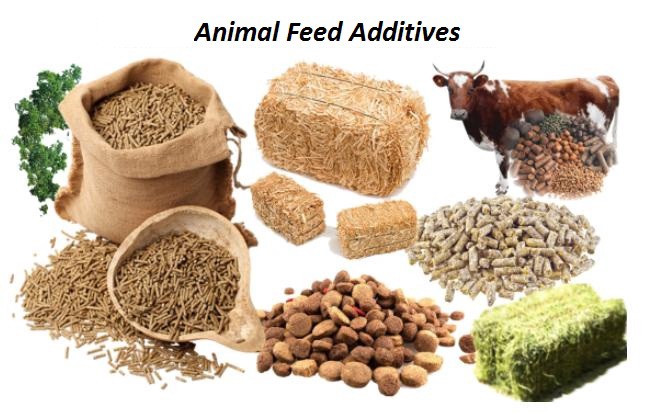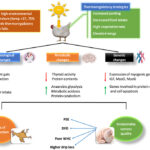
1. Introduction
Feed additives are non-nutritive substances added to ruminant diets in small quantities to improve growth performance, feed efficiency, health, and productivity. These compounds are not required for basic nutrition but modulate digestion, metabolism, immunity, or microbial activity to achieve specific production goals.
With increasing demand for efficient, safe, and sustainable livestock production, feed additives play a pivotal role in commercial ruminant (cattle, buffalo, sheep, goat) systems.
2. Objectives of Using Feed Additives in Ruminants
- Enhance rumen fermentation and microbial balance
- Improve feed conversion ratio (FCR)
- Increase milk yield, growth rate, and meat quality
- Reduce incidence of diseases and metabolic disorders
- Control bloat, acidosis, and methane production
- Replace or reduce use of antibiotics and synthetic chemicals
3. Classification of Feed Additives
Feed additives can be categorized based on their primary functions:
A. Rumen Modifiers
1. Ionophores
- Examples: Monensin, Lasalocid, Salinomycin
- Function: Alter rumen microbial populations to improve energy metabolism.
- Benefits:
- Increase propionate production (energy-rich VFA)
- Reduce methane emissions
- Control coccidiosis in young animals
- Improve weight gain and FCR
- Use: Often included in feedlots and dairy TMR systems (caution in lactating cows due to milk residue concerns).
2. Buffers and Neutralizers
- Examples: Sodium bicarbonate, Magnesium oxide, Limestone
- Function: Stabilize rumen pH to prevent acidosis, especially in high-concentrate diets.
- Benefits:
- Enhance fiber digestion
- Support higher dry matter intake
- Improve milk fat content
B. Digestive Enhancers and Enzymes
1. Exogenous Enzymes
- Examples: Cellulase, Xylanase, Amylase
- Function: Break down plant cell walls and starch to improve nutrient availability.
- Benefits:
- Increase digestibility of low-quality roughages
- Improve feed efficiency and energy extraction
2. Probiotics (Direct-Fed Microbials)
- Examples: Lactobacillus spp., Bacillus spp., Saccharomyces cerevisiae (yeast)
- Function: Supplement beneficial microbes to enhance gut health and fermentation.
- Benefits:
- Stabilize rumen flora
- Improve immunity and reduce diarrhea
- Enhance milk yield and daily weight gain
C. Metabolic Modifiers
1. Beta-adrenergic Agonists (Growth Promoters)
- Examples: Ractopamine, Zilpaterol (regulated in many countries)
- Function: Redirect nutrients from fat deposition to lean tissue accretion.
- Benefits:
- Increase lean meat yield
- Improve feed conversion
- Use: Mostly in beef finishing rations (subject to legal restrictions).
2. Hormonal Additives (Limited Use)
- Examples: Bovine somatotropin (bST)
- Function: Enhance milk production by influencing metabolism.
- Regulation: Banned in EU, used in some U.S. systems; controversial due to animal welfare concerns.
D. Nutritional Enhancers and Bypass Nutrients
1. Rumen-Protected Amino Acids
- Examples: Methionine, Lysine
- Function: Bypass rumen degradation and improve protein supply to the small intestine.
- Benefit: Enhance milk protein yield and reproductive efficiency.
2. Rumen-Protected Fats
- Examples: Calcium salts of fatty acids
- Function: Provide high-energy supplementation without affecting rumen fermentation.
- Benefit: Support early lactation, body condition, and reproduction.
3. Chelated Minerals
- Examples: Zinc-methionine, Copper-proteinate
- Function: Enhance mineral bioavailability and immune function.
- Benefits:
- Improved hoof and skin health
- Enhanced fertility and antioxidant status
E. Phytogenic and Natural Additives
1. Essential Oils and Plant Extracts
- Examples: Thymol, Eugenol, Garlic oil, Saponins
- Function: Modulate rumen microbes, reduce methane, improve palatability.
- Benefits:
- Alternative to antibiotics
- Antioxidant and antimicrobial properties
- Improve digestion and milk production
2. Tannins and Saponins
- Source: Legumes, tree leaves (e.g., Acacia, Shinoda)
- Function: Modify protein degradation in the rumen, reduce bloat and parasitic load.
F. Health Modifiers and Mycotoxin Binders
1. Mycotoxin Binders
- Examples: Bentonite, Zeolite, Activated charcoal, Yeast cell wall
- Function: Bind and neutralize toxins from contaminated feed.
- Benefit: Prevents reproductive losses, diarrhea, and immune suppression.
2. Immunomodulators
- Examples: Beta-glucans, Nucleotides
- Function: Strengthen immune response, especially in calves and transition cows.
4. Use of Additives in Ruminant Life Stages
| Animal Category | Additives Commonly Used |
|---|---|
| Calves | Probiotics, vitamins, organic acids, coccidiostats |
| Heifers | Yeast, minerals, ionophores (limited use), enzymes |
| Lactating Cows | Buffers, protected fats/amino acids, yeast, ionophores |
| Dry Cows | Chelated minerals, anionic salts, mycotoxin binders |
| Beef Cattle | Ionophores, beta-agonists, enzymes, phytogenic compounds |
5. Safety and Regulatory Aspects
- Dosage and withdrawal periods must be followed strictly.
- Antibiotic alternatives are preferred due to residue and resistance concerns.
- Monitor for toxicity or adverse interactions with other feed components.
- Regulatory frameworks differ by country (e.g., FDA, EFSA, PSQCA).
6. Conclusion
Feed additives and performance modifiers are integral tools in modern ruminant nutrition, helping to bridge the gap between traditional feeding and high-performance demands. Their judicious and scientifically guided use can:
- Increase productivity
- Improve animal welfare
- Reduce environmental impact
- Enhance economic returns
However, it’s essential to evaluate cost-benefit, ensure compliance with regulations, and monitor animal response continuously for maximum impact.




Reg. No. 23-cuvas-0308
kBoXh wSAMM rKyfSnpb
Reg# 23-CUVAS-0315
23-CUVAS-0303
23-cuvas-0336
Laiba Hafeez
Reg no : 23-cuvas-0298
Reg#:23-CUVAS-0312
DVM 4TH
Sweet
23-Cuvas-0295
DVM 4th
23-cuvas-0314
23-CUVAS-0291
Preetam Raam
23-CUVAS-0334
DVM 4th
23-CUVAS-0325,
23-cuvas-0617
23-CUVAS-0337
DVM(4th semester)
23-cuvas-0320
DVM 4 th semester
23-cuvas-0320
DVM 4 th semester
Muhammad Ahmad. 23-cuvas – 0316. DVM 4th
Laiba Hafeez
Reg no :23-cuvas-0298
DVM 4th semester
0333
Waseem
23- cuvas -0321
Talha Waheed
23-CUVAS-0305
23-cuvas-0300
Abdullah Sharif 23-Cuvas-0332 DVM 4th semester Awesome helping material
23-CUVAS-0325,
Москва. Психолог Москва. Психолог онлайн. Консультация психолога в МСК Психолог в Москве.
Запись на прием, оплата, подробная информация о специалистах и отзывы клиентов.
Индивидуальное консультирование.
65553 проверенных отзывов.
Психолог владеет множеством приемов и техник, которые помогут разобраться в себе.